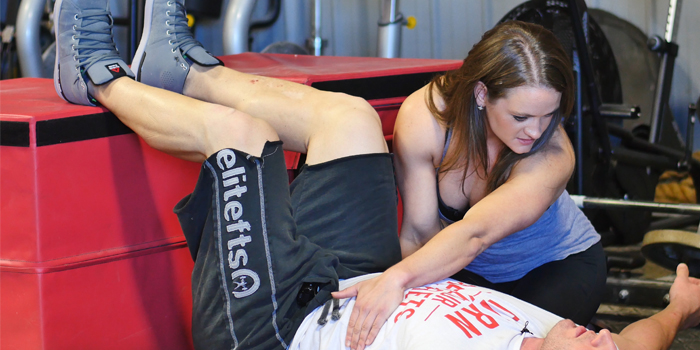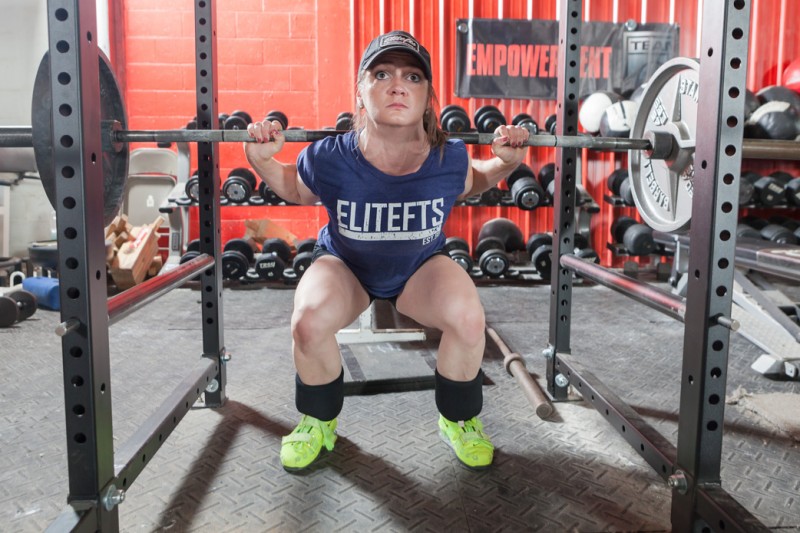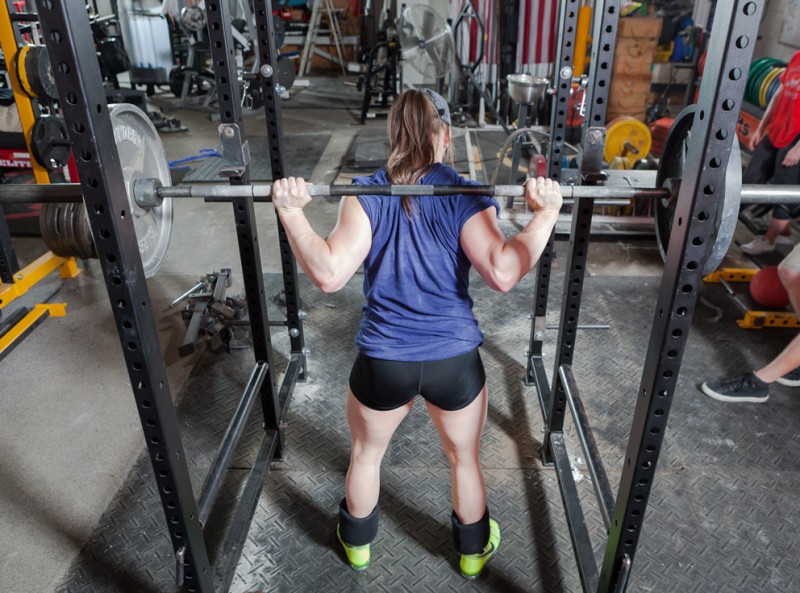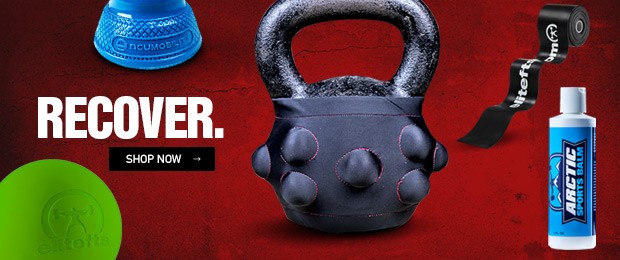
I'll admit, I hardly ever do any overhead pressing. I’ve always found more benefit (personally) from a secondary bench accessory movement and, if I press at all, it’s never been for more than six to eights weeks at a time. I’ve generally treated anything overhead as a way to improve strength or for the intent of hypertrophy. But lately, all my thinking about the lats, thoracic mobility (where our uprightness “really” comes from), and the ribcage has had me thinking a lot about the overhead press and overhead position. They can tell you a lot about a person’s pattern, position, and movement quality.
Last weekend, JP Price and I did a seminar at a local CrossFit gym. JP and I share some similar thoughts with regards to rib position, bracing, and addressing “where a movement is really coming from." JP is also ridiculously strong, and I’ve seen him log press somewhere upwards of 400. Hearing him talk about his cues, what he thinks about, and what he’s really trying to accomplish got me thinking about a number of indicators.
1. Rib Packing
Your ability to attain this optimizes position and bracing. JP and I kind of had an aha moment when we realized we see so eye-to-eye on this a few weeks ago. He’s worked hard on packing his ribs to make sure his mobility is coming from some place other than his lumbar spine. I talked a lot about rib packing in the series I did with Casey because it’s a vital component to really being able to brace effectively.
Here’s what I mean about rib packing: your ribs tell me a few things. First, they tell me about diaphragmatic position. Your diaphragm is like any other muscle in the body in that it needs to be in a good position to have mechanical advantage to work. When a lifter’s ribcage pops up, or flares, it usually tells me the diaphragm can’t effectively create the pillar you need through your core. Your ribcage also tells me an important bit of information about your obliques, given that they run from the ribcage down to the pelvis. In a position where the ribcage is flared, obliques have generally lost their mechanical advantage to properly stabilize the pelvis and the ribcage. These two common errors are what I see when someone overly extends through their low back and is essentially what Chris Duffin has discussed in his open versus closed scissor position videos. Your ability to brace improves dramatically when you can position your ribcage appropriately.
RELATED: Overhead Pressing for a Bigger and Safer Bench Press
Where most athletes get this concept wrong is when they lose thoracic position as they attempt to drop their ribcage. If, when you or an athlete drops the ribcage, you feel or see shoulders drop, a few different things are occurring: an attempt at utilization of the rectus abdominis to “depress” rather than centralize the ribcage, and loss of an upright thoracic position. From a PT standpoint, this tells me a bit more about what’s happening in the back of the ribcage, but that’s another article for another day. Many athletes who are lat-dominant and lat-driven tend to brace effectively but lose shoulder blade/thoracic position (e.g. the shoulder rounding). It’s something that both JP and myself have been working on and takes some time, coupled with lat inhibition strategies, which is where some of the overhead position becomes difficult for lat-driven individuals especially. Being able to attain what I’ll call a zone of apposition (ZOA) properly creates stability throughout your core but can be tough to maintain when coupled with shoulder mobility, given the tendency of your lats to either pull into increased lumbar extension or shoulder rounding, given its attachment on the humerus. The ability to find and attain the overhead position without losing a ZOA or rib packed position can be used as a mobility indicator in that way when combined with other assessments. It provides you another data point.
2. Breathing: How, When and Where You Put the Air
Obviously, I’m big on this breathing thing. It tells so much about the state of your nervous system and can give some vital information about muscular tone changes. From a practical standpoint, aside from the idea of rib packing and bracing, what your breath does controls what your ribcage does. Your ribcage is what your shoulder blade sits on, and can be thought of as the “roots” of the tree that is your overhead press. Your press needs a good base to sit on, and often times, an inability to put your breath into your ribcage, rather than into your neck and/or upper chest, can cause a breakdown in stability. Where you put your breath determines how strong your base really is, and will either prevent energy leakage or contribute to it.
One of the things I really took away from listening to JP talk was the cue of when he takes his breath. He’s learned that for him, at a certain weight threshold with his log clean and press, he has to be more intentional about keeping everything done in one breath, or he loses position too easily and can't generate the power he needs to finish the lift. Makes sense, but for some reason, I’d never thought about it.
If he breathes before his clean and then breathes again once he’s in the clean position before the press, he’s completely changed his base and likely leaked stability out somewhere. There’s a threshold where he can no longer afford to lose stability, different from when he’s completing rep work. I’m sure for some there’s a way to optimize taking a second breath that differs between lifters, but I think in some ways this type of training forces breath intentionality and ribcage position (which again, is predominantly influenced by breathing and bracing mechanics) that can likely have good carry over to training in the big three simply by growth of intention.
3. Requisite Mobility and Stability
In general, I think you see a lot of similarity in torso position with poor execution of both the squat and the overhead press: ribs start to flare and low back becomes essentially the fulcrum from which you press. For a lot of people I treat, this is a pretty common theme. It’s common knowledge that one major strategy people like to employ is increased lumbar extension. What I love about the press is that it messes with your proprioception by starting with the bar high off the ground.
Here’s what I mean: Trying a bodyweight squat on a stable chair or bench feels a little different than doing it on the ground, yeah? Same movement, different feel, different safety perception. The overhead position, even with submaximal weight, will challenge the ability to maintain stability. Jason Colley and I had a pretty cool conversation at the compound this weekend regarding how much we agreed on the role of decreased threat perception to let your brain remove the parking brake it has put on your mobility. From a more obvious standpoint, even getting to an overhead position while maintaining the rib packing mentioned above can expose some significant mobility, stability, or integration deficits. I don’t mean the kind of mobility you can “force” yourself into at the expense of good joint position. I mean the kind of mobility you actually have good access to without breaking a sweat just to even “find” it. You will find you are much more challenged to find this and encourage good muscle length from that rib packed position because it actually requires elongation without compensation.
Honestly, I think that pressing in some regard is an incredibly effective tool for teaching proper bracing, proper packing, and breath intentionality from both the perspective of rehab, as well as for a novice lifter. Every seminar I’ve been to and every coach I’ve talked to cannot talk about a lift without getting to the idea of breath. And duh, because breath is breaking. It's stability. It's our “leakage prevention.” It’s our lock.
WATCH: The Strength Coach Development Center — Overhead Press Progression
I look at a lot of Olympic lifters and their ability to generate a stable base overhead, their overall mobility, and their ability to keep both their upper and lower back in a good position (relative to powerlifting). I can’t help but wonder the degree to which the ability to achieve a technically sound overhead reflects a number of variables that, if we attained in powerlifting, would demonstrate carry over to our big three simply by nature of a healthier nervous system and improved movement quality. We’re generally locked up, chained up, or have accumulated excessive damage already. This is not so much the case with quite a few Olympic lifters, and I can’t help but wonder if part of it is because, in order to compete in their sport, they must be able to attain a position that requires a lot of our body.
Granted, for most intermediate level lifters this is incredibly technique and load dependent, but I do think there’s something to be said for an intermediate lifter being able to properly attain and maintain overhead and its reflection of generalized “good” patterns that can integrate well to the big three.

Try these exercises below to challenge upright position and ability to press properly. If these seem easy right off the bat, you’re likely letting yourself or your athlete cheat somewhere in the pattern. Remember to keep ribcage and pelvis oriented to face each other to achieve “rib packing,” and maintain that position as you attempt the movements.
1. Half-Kneeling Press
Get sideways by a mirror for this one, because you probably won’t sense your compensation. The half-kneeling position puts a bit more demand on the hips and core to stabilize. If this is easy as is, you can increase the stability demand by going bottoms-up position with a kettlebell. I’ve said over and over again that stability is the mother of strength: train stability and core control here. Proprioceptive stability can help unlock whatever parking break our nervous system has put on that contributes to making a muscle appear tight. When the half-kneeling position becomes easy, progress to a tall kneeling.
2. Z-Press
This one really challenges core stability. Given you’ll likely be pressing much less in this position (remember, ribs locked, brace, and breathe with intentionality), it’s a practical way to challenge your body without incurring excessive stress given the relative intensity.
3. Banded RNT Overhead Squat
This always seems easy until you try it. This can be incredibly useful for teaching bracing strategy while maintaining good shoulder blade and thoracic position with a neutral spine. I find this one is incredibly useful, especially for training women, in that it incorporates bracing strategies while promoting upper back tightness and stability. But it needs to be performed correctly to reap maximal benefits. The trick with this one is to only permit as much motion as an athlete can maintain a neutral spine, ribs packed, or whatever shade of gray you’re trying to get them to find. The achievable range should improve as the athlete continues to practice, but encourage crisp, tight movements, especially for ladies. You can add a pause at the bottom as well for further positional learning.
I’m not going to say overhead is for everyone. It’s not. It’s a position that, in general, compromises shoulder position, especially given the fact that our culture lends itself to posturing that alters joint position. If there’s pathology, prior surgery, or some other conglomeration of factors, you probably don’t need to be loading that position with weight. But, you should at least be able to attain the basis or foundation for it in so far as it can reflect the ability to achieve proper movement and bracing strategies when cued and utilized correctly. If you’ve got athletes with shoulders that cave on a squat, or have a hard time bracing without losing spine position at the bottom of a squat, maybe think a little unconventionally and utilize an entirely different compound to find the source of their breakdown.











